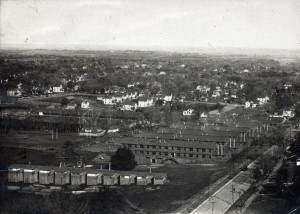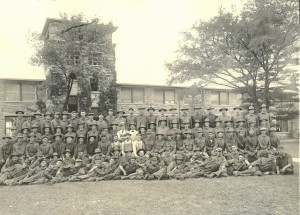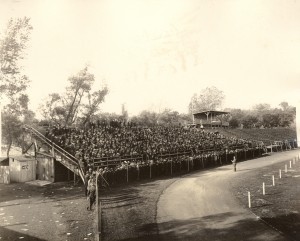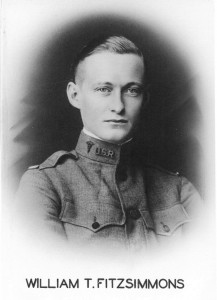World War I and KU: A Reflection on the 100 year Anniversary
July 3rd, 2014June 28, 2014 marked the unofficial 100 year anniversary of the beginning of World War I. On that day 100 years ago, Archduke Franz Ferdinand of Austria was assassinated. That tragic moment put into motion the dominoes that would fall one month later, resulting in a war that would last four years and forever change the course of history. As the world looks back on this event, I wanted to find what connections the University of Kansas had to the Great War. Simply put: there are a lot. For this entry, I will focus on the beginnings of KU’s involvement with the war. From the Student Army Training Corps (SATC)—a forerunner of the ROTC on campus—to the first American army officer killed, KU becomes forever linked with the Great War.
Overview of the SATC barracks that were constructed on campus. The barracks cost $180,000 and helped house the influx of 2,500 soldiers. University Archives, call number 0/22/89 1918. Click image to enlarge.
Group of SATC classes pose in front of Fowler Shops with the instructors in the center. Classes included carpentry, machinery, auto shop, blacksmith, telegraphy, and radio. University Archives, call number 29/0 1918.
Click image to enlarge.
The University of Kansas Graduate Magazine issues during 1917-1919 offer valuable insight about campus life before, during, and after the United States joined the war. One topic of contention was the SATC. Wanting to make itself fully available for the service of the country, while also still providing quality education to its students, the university administration struggled to produce a compromise. The result was a majority of War Department approved courses combined with a required course on “war aims” to understand the multitude of causes of the conflict. The photographs below are just a sampling of what these courses, including Red Cross classes for women, looked like on campus almost 100 years ago.
SATC Commander Scher talks with a group at McCook Field in 1918.
University Archives, call number 29/0 1918. Click image to enlarge.
SATC telegraph class members practice wigwagging (sending messages by moving two flags according to a code) on the University’s campus. University Archives, call number 29/0 1918. Click image to enlarge.
Of the 9 million war casualties, 129 were KU men and women. Of those 129, Dr. William T. Fitzsimmons was the first American army officer killed in the war. Fitzsimmons was born in Burlington, Kansas, graduated from the University of Kansas in 1910, and received his M.D. in 1912. A lieutenant in the Medical Reserve Corps, he was stationed in France at an allied hospital base. On the night of September 4, 1917, Fitzsimmons’ unit was bombed by airplanes. His death saddened and shocked the university community, bringing what seemed like a distant war immediately closer to home.
Portrait of William T. Fitzsimmons, the first KU (and American) officer to be killed in World War I.
University Archives, call number 0/22/54 1918. Click image to enlarge.
JoJo Palko
University Archives intern





